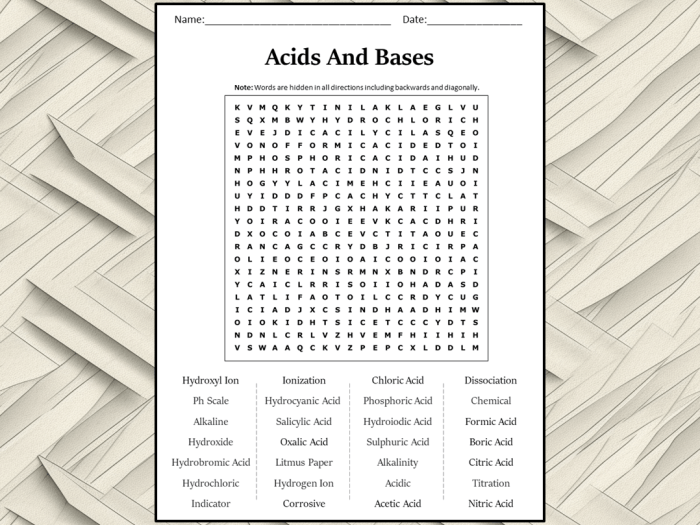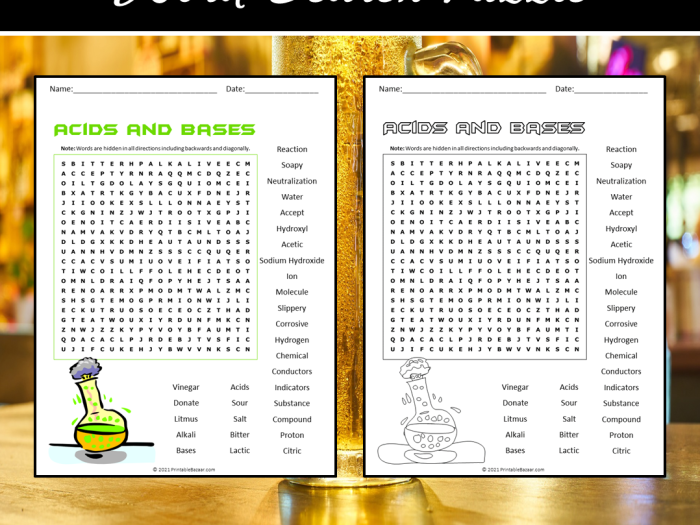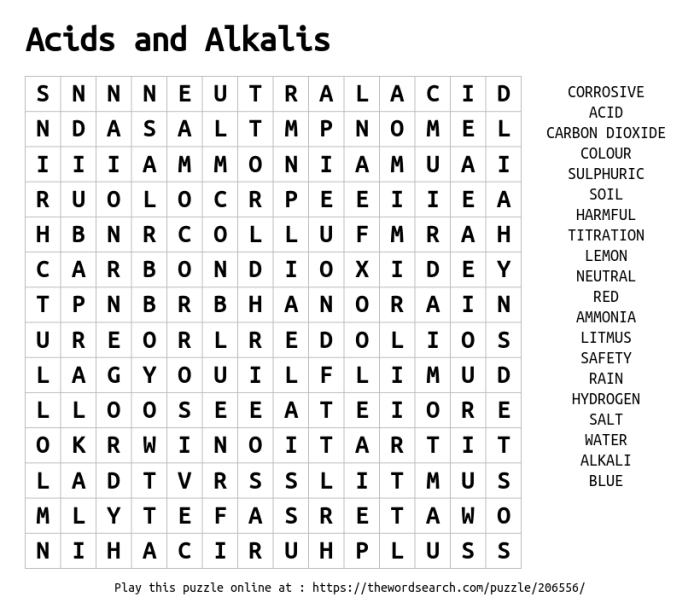Acids and bases word search – Embark on a captivating journey into the realm of acids and bases with our word search adventure! Discover the fascinating world of chemical reactions, pH levels, and everyday applications in a way that is both engaging and accessible.
From the fundamental definitions of acids and bases to their remarkable properties and wide-ranging uses, this comprehensive guide will unravel the secrets of these essential chemical concepts.
Definitions of Acids and Bases

Acids and bases are fundamental chemical concepts that describe substances’ properties and their behavior in chemical reactions. Understanding their definitions is crucial for comprehending chemical interactions and reactions.
If you’re feeling stumped on your acids and bases word search, take a break and test your literary knowledge with our To Kill a Mockingbird quiz . Brush up on your understanding of Harper Lee’s classic novel and return refreshed to tackle those tricky acid-base terms.
Arrhenius Definition
According to the Arrhenius definition, acids are substances that produce hydrogen ions (H+) when dissolved in water, while bases produce hydroxide ions (OH-) when dissolved in water. This definition is based on the behavior of acids and bases in aqueous solutions.
Brønsted-Lowry Definition
The Brønsted-Lowry definition defines acids as substances that donate protons (H+), while bases are substances that accept protons. This definition focuses on the transfer of protons between acids and bases, rather than their behavior in aqueous solutions.
Lewis Definition
The Lewis definition generalizes the Brønsted-Lowry definition by considering electron pairs instead of protons. According to the Lewis definition, acids are substances that accept electron pairs, while bases are substances that donate electron pairs. This definition encompasses a wider range of chemical reactions, including those that do not involve proton transfer.
Properties of Acids and Bases

Acids and bases exhibit distinct physical and chemical properties that help differentiate them. These properties are crucial in understanding their behavior in various chemical reactions.
Physical Properties
Acids and bases exhibit contrasting physical properties. Acids are typically sour to the taste, corrosive, and have a pH less than 7. On the other hand, bases are bitter, slippery to the touch, and have a pH greater than 7.| Property | Acid | Base ||—|—|—|| Taste | Sour | Bitter || pH | < 7 | > 7 || Conductivity | Good | Good || Corrosiveness | Corrosive | Non-corrosive || Feel | Irritating | Slippery |
Chemical Properties
Acids and bases undergo characteristic chemical reactions that highlight their unique properties.Reaction with Metals:Acids react with active metals like zinc and magnesium to produce hydrogen gas. This reaction is accompanied by the formation of a salt.“`
HCl + Zn → ZnCl2+ H 2
“`Reaction with Carbonates:Acids react with carbonates to release carbon dioxide gas. This reaction is commonly used to test for the presence of carbonates.“`
HCl + Na2CO 3→ 2NaCl + H 2O + CO 2
“`Reaction with each other:Acids and bases react with each other in a neutralization reaction, forming a salt and water. This reaction is often used to determine the concentration of an acid or base.“`HCl + NaOH → NaCl + H 2O“`
pH and Acidity/Basicity
The pH of a solution is a measure of its acidity or basicity. It is a numerical value that ranges from 0 to 14, with 7 being neutral. Solutions with a pH less than 7 are acidic, while those with a pH greater than 7 are basic.
The pH of a solution can be measured using a pH meter or pH paper.
Applications of Acids and Bases

Acids and bases play a significant role in our daily lives, as well as in various industries. Let’s explore their applications in different fields.
Uses of Acids in Everyday Life
- Food and beverages:Acids, such as citric acid, ascorbic acid (vitamin C), and phosphoric acid, are used as flavorings, preservatives, and acidity regulators in food and drinks.
- Household cleaning:Hydrochloric acid and sulfuric acid are common ingredients in toilet bowl cleaners, drain cleaners, and rust removers.
- Batteries:Sulfuric acid is used in lead-acid batteries, which are commonly found in vehicles and backup power systems.
- Fertilizers:Nitric acid and sulfuric acid are used in the production of fertilizers, which provide essential nutrients for plant growth.
Uses of Bases in Everyday Life
- Household cleaning:Sodium hydroxide (lye) and ammonia are used in oven cleaners, drain openers, and degreasers.
- Personal care:Sodium hydroxide is used in the production of soap and shampoo, while baking soda (sodium bicarbonate) is a common ingredient in toothpaste and deodorant.
- Medicine:Magnesium hydroxide is used as an antacid to neutralize stomach acid, while calcium carbonate is used as a calcium supplement.
- Construction:Cement, which is a mixture of calcium oxide and other materials, is used in the construction industry for making concrete and mortar.
Importance in Industries
Acids and bases are indispensable in various industries, including:
- Food industry:Acids are used as preservatives, flavorings, and acidity regulators in food and beverage production.
- Medical industry:Acids and bases are used in the production of medicines, such as antibiotics and pain relievers, as well as in diagnostic tests and medical procedures.
- Manufacturing industry:Acids are used in the production of plastics, dyes, and other chemicals, while bases are used in the production of paper, textiles, and detergents.
Acid-Base Reactions

Acid-base reactions are chemical reactions that involve the transfer of protons (H+) between an acid and a base. These reactions are fundamental to many chemical processes, including digestion, respiration, and industrial processes.
There are three main types of acid-base reactions:
- Neutralization reactions
- Precipitation reactions
- Gas evolution reactions
Neutralization Reactions
Neutralization reactions occur when an acid and a base react in stoichiometric proportions to form a salt and water. The salt is a compound that contains the cation of the base and the anion of the acid.
For example, the neutralization reaction between hydrochloric acid (HCl) and sodium hydroxide (NaOH) produces sodium chloride (NaCl) and water (H2O):
HCl + NaOH → NaCl + H2O
Precipitation Reactions
Precipitation reactions occur when an acid and a base react to form an insoluble solid precipitate. The precipitate is a compound that is formed when the ions of the acid and the base combine to form a new compound that is insoluble in the reaction medium.
For example, the precipitation reaction between sulfuric acid (H2SO4) and barium hydroxide (Ba(OH)2) produces barium sulfate (BaSO4) and water (H2O):
H2SO4 + Ba(OH)2 → BaSO4(s) + H2O
Gas Evolution Reactions
Gas evolution reactions occur when an acid and a base react to produce a gas. The gas is usually hydrogen gas (H2), which is produced when an acid reacts with a metal.
For example, the gas evolution reaction between hydrochloric acid (HCl) and zinc (Zn) produces hydrogen gas (H2) and zinc chloride (ZnCl2):
HCl + Zn → H2(g) + ZnCl2
Factors Affecting the Rate of Acid-Base Reactions
The rate of acid-base reactions is affected by several factors, including:
- The concentration of the acid and the base
- The temperature of the reaction
- The presence of a catalyst
The concentration of the acid and the base is the most important factor affecting the rate of an acid-base reaction. The higher the concentration of the acid and the base, the faster the reaction will proceed.
The temperature of the reaction also affects the rate of an acid-base reaction. The higher the temperature, the faster the reaction will proceed.
The presence of a catalyst can also affect the rate of an acid-base reaction. A catalyst is a substance that speeds up a chemical reaction without being consumed by the reaction.
Acid-Base Titrations: Acids And Bases Word Search
Acid-base titrations are a fundamental technique in analytical chemistry used to determine the concentration of an unknown acid or base. They involve a controlled reaction between a known volume of an acid and a base (or vice versa) until the reaction reaches a point of equivalence, known as the endpoint.
Procedure
- Measure an accurately known volume of the unknown acid or base into a flask.
- Add a few drops of a suitable indicator to the flask.
- Fill a buret with a solution of known concentration (the titrant) and slowly add it to the unknown solution while swirling the flask constantly.
- Observe the color change of the indicator, which signals the endpoint of the titration.
- Record the volume of titrant used to reach the endpoint.
Role of Indicators, Acids and bases word search
Indicators are weak acids or bases that undergo a color change at a specific pH range. When added to an acid-base titration, they indicate the endpoint by changing color when the pH of the solution reaches a particular value. This allows the analyst to determine when the reaction has reached equivalence.
Calculations
The concentration of the unknown acid or base can be calculated using the following formula:
M1V 1= M 2V 2
where:
- M 1is the molarity of the known solution (titrant)
- V 1is the volume of the known solution used
- M 2is the molarity of the unknown solution
- V 2is the volume of the unknown solution
By rearranging the formula, the molarity of the unknown solution can be determined:
M2= (M 1V 1) / V 2
Frequently Asked Questions
What is the difference between an acid and a base?
Acids release hydrogen ions (H+) in water, while bases release hydroxide ions (OH-) in water.
What is the pH scale?
The pH scale measures the acidity or basicity of a solution, ranging from 0 (most acidic) to 14 (most basic).
What are some common uses of acids and bases?
Acids are used in batteries, fertilizers, and food preservation. Bases are used in cleaning products, soaps, and antacids.

